You are here
| Size | Seeds | Peers | Completed |
|---|---|---|---|
| 112.78 MiB | 0 | 0 | 0 |
The Great Serpent Mound (Ohio)
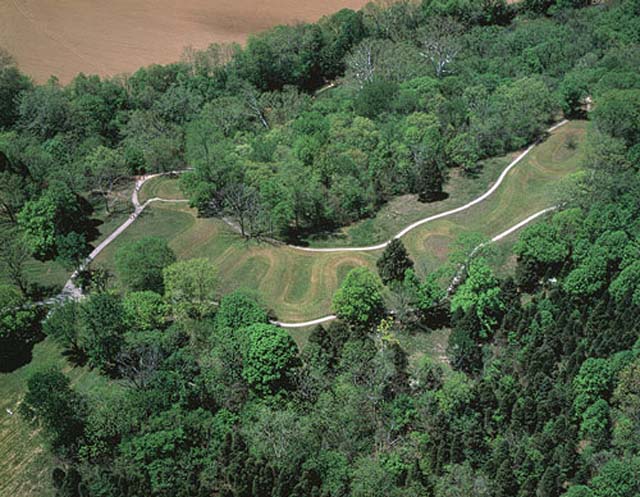
The Great Serpent Mound of Adams County, Ohio, near Peebles. Serpent Mound, at 1,330 feet, is the largest effigy mound in the world.
Driving through the rolling countryside of southern Ohio, one can understand why our ancient predecessors in this American continent chose the serpent to symbolize the immanent power of the land. Passing east through the foothills of the Appalachians in southern Ohio, a turn to the north — into the domain of the serpent — quickly brings the adventurer through wave after wave of fertile, rolling hills that seem to brim with numinous power. This is old farm country, Amish country, a place of faith both ancient and modern. This is rural Ohio.
http://www.greatserpentmound.org/
Serpent Mound Part 1: Great Serpent
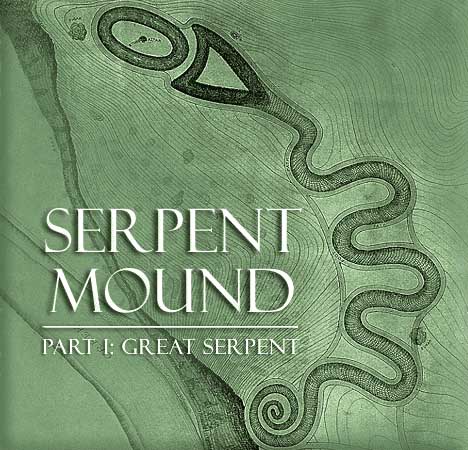
Driving through the rolling countryside of southern Ohio, one can understand why our ancient predecessors in this American continent chose the serpent to symbolize the immanent power of the land. Passing east through the foothills of the Appalachians in southern Ohio, a turn to the north — into the domain of the serpent — quickly brings the adventurer through wave after wave of fertile, rolling hills that seem to brim with numinous power. This is old farm country, Amish country, a place of faith both ancient and modern. This is rural Ohio.
Located in southwest Ohio in Adams County, near the small farm town of Peebles, the Great Serpent Mound has long been considered one of the most famous and enigmatic archaeological remnants of the ancient world. Though other serpent mounds can be found as far afield as ancient Britain and Mexico, Ohio's serpent mound is by far the largest and most interesting serpentine effigy mound in the world. Moreover, though the Serpent Mound acropolis is not as extensive as Iowa's Effigy Mounds, taken as a single mound it far exceeds even the massive Great Bear Mound in both size and sheer spectacle, making it the largest animal effigy mound in the world.
http://www.mysteriousworld.com/Journal/2003/Spring/SerpentMound/
Serpent Mound Part 2: Sacred Serpent
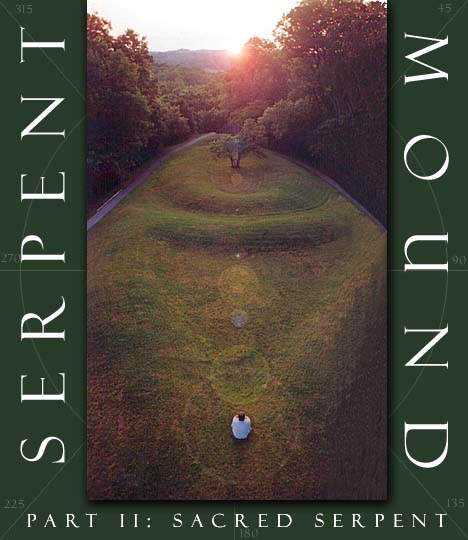
The origin of the Great Serpent Mound is in some dispute. It was originally assumed that the Serpent Mound was built by the Adena, due to the existence nearby Adena burials. However, others believe that it is likely Hopewell in origin, as it appears to more closely match their level of skill and predilections in its form and function. Recently, more fuel has been added to the debate with the carbon dating of some wood charcoal taken from the mound, which placed the building of the mound during the Fort Ancient period: "Two samples of wood charcoal were obtained from undisturbed parts of Serpent Mound. Both yielded a date of ca. A.D.1070, suggesting that the effigy was actually built by people of the Fort Ancient culture."12
This is not definitive proof, however, as Romain explains: "It may be that charcoal samples recovered by Fletcher and Cameron's team were inadvertently recovered from layers of earth that were added to the effigy by Frederick W. Putnam of the Peabody Museum in an effort to restore the Serpent Mound to its original height".13 Putnam, a prominent archaeologist in the latter half of the nineteenth century, had been charged with surveying the mound in 1883, and was later instrumental in recovering the mound from further destruction by farming. Putnam had taken great care in restoring the mound to its original shape and height but, in the process of restoring the mound, had added dirt from nearby sources. As a result, the specimen had been tainted and, as Romain has correctly deduced, would require a more thorough testing in order to account for that variable. So, for this reason and many more, Romain remains convinced that the Serpent Mound is of Hopewell origin.
In my opinion the effigy is of Hopewell origin. This opinion is based upon several observations. First, the structure exhibits a geometric complexity that is more typical of Hopewell than either Adena or Fort Ancient. Second, there is clear evidence that the Serpent Mound builders used lesser multiples of the 1,053-foot unit of length commonly used by the Hopewell. Third, the serpent effigy incorporates various astronomical alignments, including alignments to the moon's mid-point as well as maximum and minimum rising and setting points. These lunar alignments appear to be exclusive to the Hopewell.14
http://www.mysteriousworld.com/Journal/2003/Summer/SerpentMound/
Serpent Mound Astronomy
In 1985, Romain embarked on a detailed physical survey of the earthwork. Through the detailed measurements that were achieved through the usage of state-of-the-art surveying equipment, he discovered numerous, clear lunar alignments and one unusual solar alignment that were very similar to alignments found in the numerous Hopewell earthworks that had previously been surveyed in the region. Like the octagonal and other mounds, the Serpent Mound displayed the same level of astronomical sophistication that only the Hopewell were capable of producing. Thus, it was logical that the Hopewell had created the Serpent Mound, as apparently only they were capable of building it.
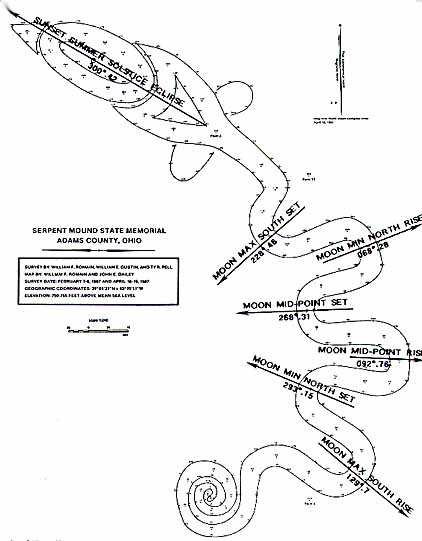
Lunar alignments correspond to six of the seven coils of the serpent effigy. The coils to the right point to the moon's maximum northern, southern, and central rising points, and the coils to the left point to the moons maximum northern, southern and central setting points. As such, the serpent is closely identified with the moon, and with the underworld. The head and oval also point to the sun's maximum northern setting point, during the summer solstice, and appear to show the sun symbolically being "swallowed" by the serpent. The serpent is also aligned to true north via a line traveling from the center of its coiled tail to the base of its head.
Romain found that the three major "coils" of the serpent neatly aligned with the maximum northern, southern, and central rising points of the moon — its "major standstills". Moreover, he found that the coils of the serpent had been arranged with such precision that their opposites also aligned closely with the maximum northern, southern and central setting points of the moon. Such a feat requires an uncommonly high degree of astronomical skill, plus an understanding of the moon's 19-year metonic cycle, which had not been discovered by the Greeks until the 5th century b.c., a mere 400 years before the time of the Hopewell. Also, the head and oval embankment point toward the sun's northernmost setting point, at the summer solstice, and the monument as a whole appears to be oriented to true north, via a line drawn from the center of its coiled tail to the base of its horned skull. Romain summarizes his discovery thusly: "In summary, these data show that eight astronomical alignments are found in the Serpent Mound. The most accurate alignment is to true north, while the next most certain alignment is through the oval embankment to the summer solstice sunset. Six lunar alignments were also found."15
Serpent Mound Mythology
The Great Serpent Mound, then, was closely associated with the moon in the minds of the ancient Hopewell, its manifold curves clearly delineating the moon's habitual haunts in the night sky. As such, it clearly fits in with the Hopewell's obsession with sacred geometry, astronomy, and architecture. Yet, some questions remain. Why choose the form of a serpent to symbolize the underworld? And why is the serpent shown apparently swallowing the sun? Romain believes that the serpent may be representative of the "Great Horned Serpent of the Underworld" of Native American myth and legend, which also attacks and swallows the sun.16
The Serpent Mound represents the struggle between the Great Horned Serpent of the underworld and the sun, with the sun represented by the oval embankment.... As to why this mythological conflict might be important enough for the Mound Builders to go to the trouble of building the Serpent Mound, we can speculate that the serpent effigy symbolized the dark forces which would include the moon, night, winter, darkness, and death; while the oval represented the sun, daytime, summer, light, and life. Notably, the summer solstice sunset alignment suggests a balance between these two opposing cosmic forces. In this scenario, we can further speculate that perhaps the Mound Builders celebrated world renewal ceremonies at the site, in order to help strengthen the powers of the upperworld in the continuing struggle against the forces of the underworld. In this way, the Serpent Mound builders would have been able to exercise some control over the forces that ruled their universe and affected their lives.... What we see in the Serpent Mound is yet another iteration of a theme that has fascinated humanity since the beginning — that is, the eternal conflict between the opposite forces of light and dark, good and evil, life and death.17
The Great Serpent Mound, then, was likely the setting for an annual ritual wherein the ancient Hopewell (and possibly the Fort Ancient peoples) regularly reenacted their most important annual ceremony in order to maintain a harmonic balance between heaven and earth and ensure the continued fertility of the land. By using the symbol of the serpent, the Hopewell were apparently attempting to sympathetically control the powers of the underworld, of night, darkness, winter, and death, by creating an symbolic image of them that was more or less under their control. In their worldview, their annual recognition of the powers of the underworld and their ability to replace the light with darkness, and the summer with winter, was absolutely necessary to maintain harmony with the cosmos and ensure that the light, summer, and life would return again the next year. Failure to do so would, in their worldview, possibly lead to their total destruction and, perhaps, that of their entire world.
Such beliefs were common throughout the ancient world, as ancient man attempted to integrate himself in closely with his environment. In ancient North America, the forces of darkness were typically symbolized by serpents, or "water spirits", whereas the forces of light were typically represented by the Thunderbird. This indicates that the Native American worldview was essentially dualistic in nature. Light and darkness, summer and winter, Thunderbird and serpent, such concepts were central to the Native American worldview. But one question remains. Who were the mysterious Hopewell, and why were they so much more advanced than their neighbors?
As we saw in Part I, the Serpent Mound was built on a prominent clifftop in an area that is important and unusual in several respects. Moreover, the amount of time, energy, and expertise required to build the mound, as well as the important information it apparently conveyed, tends to lead to the conclusion that the Great Serpent Mound was one of the greatest ceremonial centers of the Hopewell, and of ancient America.
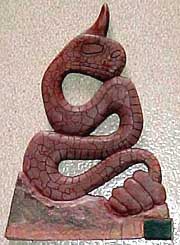
A Cherokee stone carving of the ledgendary Great Horned Serpent known as "Uktena." The Great Serpent Mound also once had projections on either side of its head which some believe were intended to represent horns.
The Great Serpent Mound Coordinates: 39° 1'35.23"N, 83°25'52.34"W
Related Links:
http://en.wikipedia.org/wiki/Serpent_Mound
http://www.statemaster.com/encyclopedia/Serpent-Mound
http://www.mysteriousworld.com/
Mounds of North America - http://www.crystalinks.com/pyrnorthamerica.html
Ross Hamilton - The Mystery of the Serpent Mound: In Search of the Alphabet of the Gods - http://books.google.ca/books?id=bhzVNWBujDEC&pg=PA43&dq=ross+hamilton+th...
William F. Romain - Mysteries Of The Hopewell (Ohio History and Culture) - http://www.amazon.com/exec/obidos/ASIN/1884836615/mysteriousworldb
Squier & Davis - Ancient Monuments of the Mississippi Valley - www.amazon.com/exec/obidos/ASIN/1560988983/mysteriousworldb#reader_15609...
Google Book Search: serpent mound - http://books.google.ca/books?ei=lyjFS-XVHoaBlAe998SADA&ct=result&q=serpe...


- Log in to post comments
